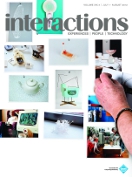Authors:
Jon Kolko
Designers, who for years have been called upon to design a single object or product, are now being asked to design entire systems, to explore experiences and emotion, and to take on large-scale social problemsso-called wicked problems. This requires a shift in skills, and with this shift has come a change in expectations by both designers themselves and the ecosystem of disciplines that surround them. The shift in expectations has not necessarily been positive. For although designers can now reap the benefits of increased salary, more control, a larger selection of meaningful projects, and professional recognition, they must also…
You must be a member of SIGCHI, a subscriber to ACM's Digital Library, or an interactions subscriber to read the full text of this article.
GET ACCESS
Join ACM SIGCHIIn addition to all of the professional benefits of being a SIGCHI member, members get full access to interactions online content and receive the print version of the magazine bimonthly.
Subscribe to the ACM Digital Library
Get access to all interactions content online and the entire archive of ACM publications dating back to 1954. (Please check with your institution to see if it already has a subscription.)
Subscribe to interactions
Get full access to interactions online content and receive the print version of the magazine bimonthly.







Post Comment
No Comments Found